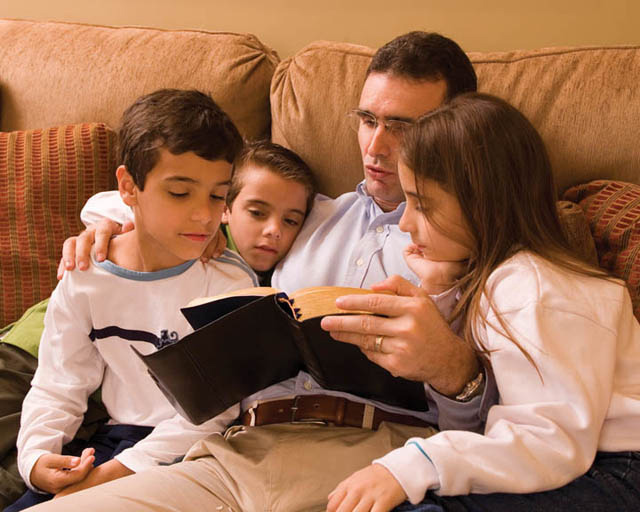Each week, I teach one to three year olds about God, Jesus, and the Bible in my Mormon nursery class. Every month,
we learn a Bible story, repeating it each Sunday for the entire month, and we also have a lesson on a basic principle of Christianity. Over the past year, I’ve learned a great deal about teaching religion to very young children.
It’s never too soon to start teaching our children. As a family, we can read the scriptures and make sure even our youngest children are in the room as we do. They are listening and will absorb whatever they are ready for.
 When I teach my lesson, my toddlers often wander around the little classroom, seemingly ignoring me. Even when no one seems to be listening, I continue to teach, knowing small bits will connect with them, and periodically invite them to look at a picture or join me for an activity. Naturally, I can’t deliver a lecture to a toddler. I use pictures, finger plays, stick puppets, and songs to get my message across. I stay with the very simplest parts of the gospel of Jesus Christ: Heavenly Father loves me; I can be happy; I can pray, Jesus is the Son of God.
When I teach my lesson, my toddlers often wander around the little classroom, seemingly ignoring me. Even when no one seems to be listening, I continue to teach, knowing small bits will connect with them, and periodically invite them to look at a picture or join me for an activity. Naturally, I can’t deliver a lecture to a toddler. I use pictures, finger plays, stick puppets, and songs to get my message across. I stay with the very simplest parts of the gospel of Jesus Christ: Heavenly Father loves me; I can be happy; I can pray, Jesus is the Son of God.
There are no heavy discussion in our ten minute lesson. If you look at a sample lesson from our manual, you’ll see how the gospel of Jesus Christ can be brought to the simplest level. This type of lesson can be easily prepared by a parent at home for a morning devotional.
If you look at the lesson, you’ll see it includes some higher level information. This is for me to study so I understand the topic well before I teach it. In teaching this lesson, I would begin with the first optional activity, which suggests bringing pictures of things I am thankful for. Sometimes I bring real objects, and put them into a bag. Each child takes turns pulling something from the bag. I then ask them what it is and briefly mention how thankful I am for that item Heavenly Father gave me. Children love to take things out of bags and to handle real objects.
Next, I’d share the story of Jesus healing the ten lepers. I show them the picture, but I often retell it using flannel board pictures. The children enjoy helping me put the objects on the board. Other times, I tell a story using stick puppets and let the children each hold one of the puppets. By telling the story several ways, they are more likely to remember it.
Next, I’d let them color the picture included with the lesson and talk to them about it as they colored. This gives them an attention break, as they have something interesting to do while they listen. Often they listen better when their hands are busy. We’d finish up with the song.
Throughout the rest of the nursery time, I’d include the songs and other activities, repeating them often to make them more familiar.
Children love repetition. As I mentioned earlier, we also learn a Bible story each month. Currently, I’m focusing on Old Testament stories. At first, I tried to do this Scripture Story Time differently each week, but I quickly learned the children prefer to do it the same way each time. By the end of the month, they know what to expect and they often enjoy joining in, where they might have ignored me the first week or two. I do vary theme-related activities during the month.
Next month, we are doing Noah’s Ark, a story children love because it’s full of animals. I keep the telling very simple and generally ignore the information that all the bad people died. They are young, so they never wonder what happened to them. I tell it like this:
“Noah was a prophet. God was sad because all the people were being bad. God told Noah to tell them to stop being bad. Noah went to the people and said, “Stop being bad! Repent!” (I shake my finger as I say this in a deep voice and invite the children to imitate me.)
During this time, I am showing them a picture of Noah preaching, so there is something to capture their attention.
“The people said, ‘No! We don’t want to.’” (I fold my arms across my chest and look defiant, and again invite them to imitate me and say it along with me.)
“Noah was sad. God was sad. God told Noah that since they wouldn’t be good, he should build an ark just for his family and the animals. (I show a picture of the ark.)
I stop here and let the children pretend to build an ark. We gather wood, stretch to put boards up high, and hammer. This gives them a movement break.
Then I tell them God gathered two of each kind of animal. We have a large painted picture of an ark made by one of the parents. I set it on the floor and spread out an assortment of wooden animals. I choose one and ask the children what it is and what it says. Sometimes we stop and imitate it, crawling around the floor. I invite one child to find it’s friend—the animal that looks just like it. This teaches matching skills, but also lets the children participate. The teachers help as needed. When the mate has been found, the child places the two animals together on the ark.
When we’re done, I tell them that when the ark was finished, Noah and his family and the animals all moved onto the ark. Then the rain started. We pretend to make rain with our fingers. But Noah, his family, and the animals were all safe and warm and dry inside.
We finish this story with a song and an action rhyme. During playtime, we’ll do other rain or animal related activities. This is a very simple lesson and will be repeated all month. By the end of the month, the older children know the story and can help tell it and the little ones are cheerful from seeing something very familiar.
When you’re doing this with your children, you can do animal and ark related activities all day long. Sing songs about Noah in the car. Do the action rhymes while waiting in the doctor’s office. Retell the story often. Make a flannel board story or a stick puppet to use for variety once in a while.
When teaching your children about God and the Bible, find the simplest aspects of the doctrine or story to teach. Little children can learn to pray with help, to understand God’s love for them, to know Jesus is their Savior (even if they don’t quite know what that means) and that they should obey the commandments. They can learn the basics of Bible stories, just as they’ve memorized their favorite storybooks and television programs. The truths they learn when they are very small are likely to stay with them all their lives.
About Terrie Lynn Bittner
The late Terrie Lynn Bittner—beloved wife, mother, grandmother, and friend—was the author of two homeschooling books and numerous articles, including several that appeared in Latter-day Saint magazines. She became a member of the Church at the age of 17 and began sharing her faith online in 1992.






